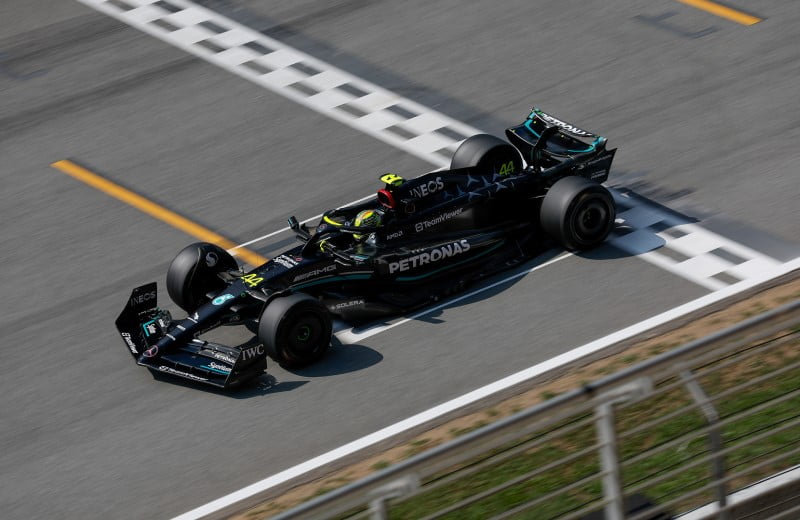2023 Canadian Grand Prix
In his section ‘F1 data prediction‘, automotive engineer Ashwin Issac analyses data from previous races that present characteristics similar to the Circuit Gilles Villeneuve in Canada. Ashwin’s F1 data prediction explains why Red Bull Racing will be the team to beat and why Mercedes could be their closest challenger.
Preface
After a week’s break, we head to a maple syrup-fueled Grand Prix in Montreal, Quebec, Canada.
The Circuit Gilles Villeneuve is a fan favorite and has hosted many memorable Grands Prix. The track layout is very simple in the sense that multiple straights are separated by chicanes and a hairpin. It’s a layout of a few corners but those corners influence the lap times significantly. The closeness of the walls adds jeopardy to the weekend.
The layout of the circuit necessitates a low-downforce setup. Cars with efficient downforce, excellent straight-line speed, and quick change in direction will have an advantage. This track also tests the braking performance and the tractability of the cars.
Based on the characteristics of the track let’s examine which team among the top 4 will be the quickest to complete a lap in Montreal.
Prognosis – to expand on the F1 data prediction for Canada
For the comparisons, data with similar variables are selected to make a viable analysis. For instance, the fastest sectors by a Formula 1 team and not individual drivers are considered for the qualifying examination.
2022 Canadian GP
Last year the qualifying session was a wet one, which mixed up the grid and it wouldn’t give us a stable base to extrapolate for this year’s qualifying.
2023 Formula 1 Season
Red Bull have been the dominating force this season, they seem very ominous, especially in the hands of Verstappen. Is there a chance for Sergio Perez or because of the favoring layout will it be 1-2 for Red Bull, let’s find out.
2023 Bahrain GP
Sector 1 of the race track in Sakhir has a few similarities to the circuit in Montreal. The heavy braking zone into turn 1 and the chicane right after that leading to another heavy braking zone at turn 4 had similar demands.
Here is a bar chart of how the current teams fared in this section of the track:
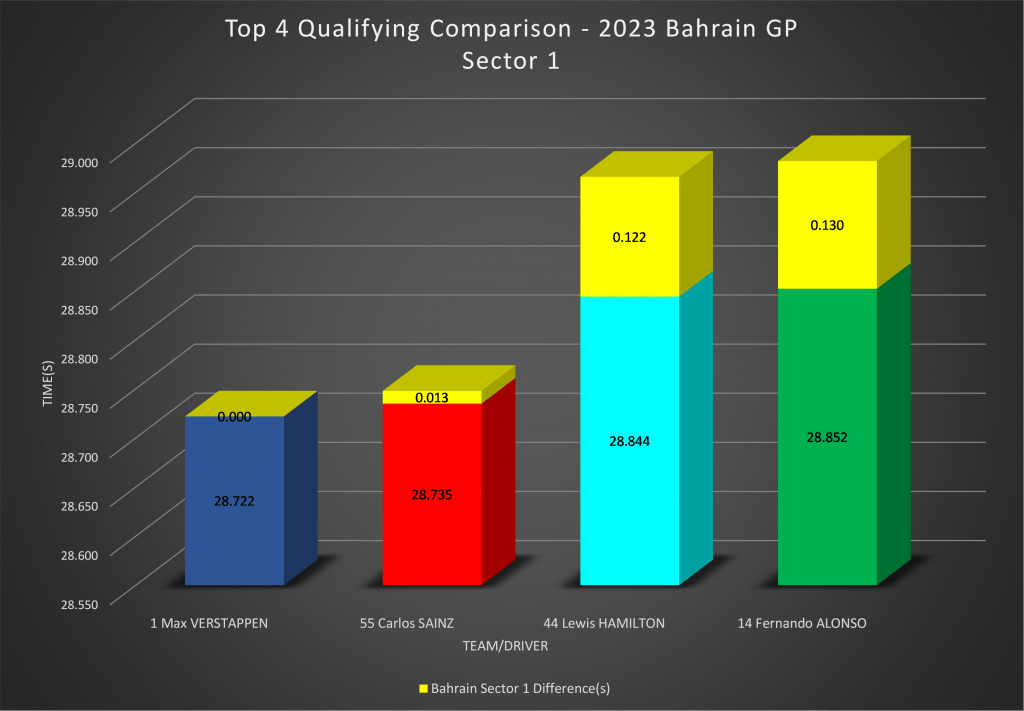
- In the first race of the season, Ferrari and Red Bull had similar times.
- Mercedes and Aston were bunched together but a tenth behind the leading duo.
The mini-sector shows the complete picture :
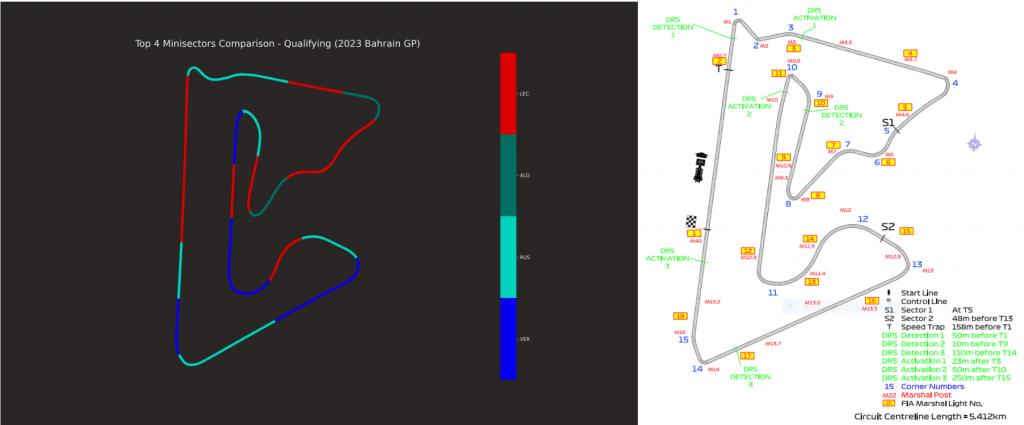
It must be noted that the Mercedes did well in the chicane and the Aston had an advantage with their braking.
2023 Australian GP
The performance at the heavy braking, traction zone with a quick change in direction at turns 1 and 2 with a medium-paced long chicane at turns 3 and 4 should be a good base to gauge the performance.
Here’s a bar chart to compare the top 4:
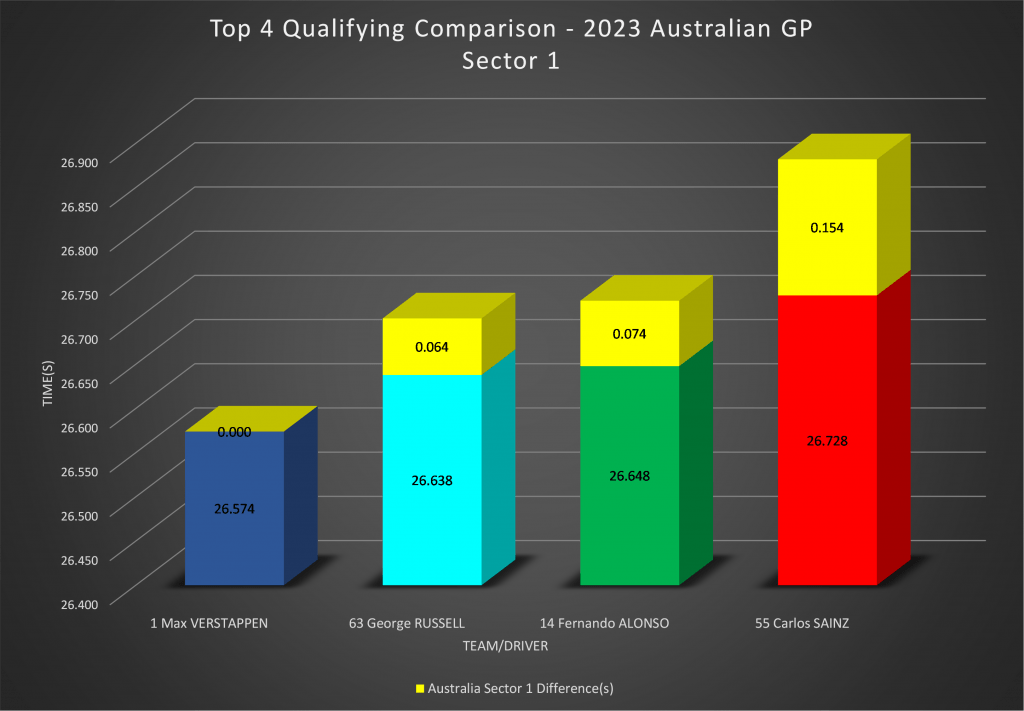
- With Verstappen as the bench line, the Mercedes and Aston were very close behind.
- The Ferrari struggled in the cooler conditions offered at Melbourne.
Let’s take a look at where the individual teams were faster in the mini-sector map:
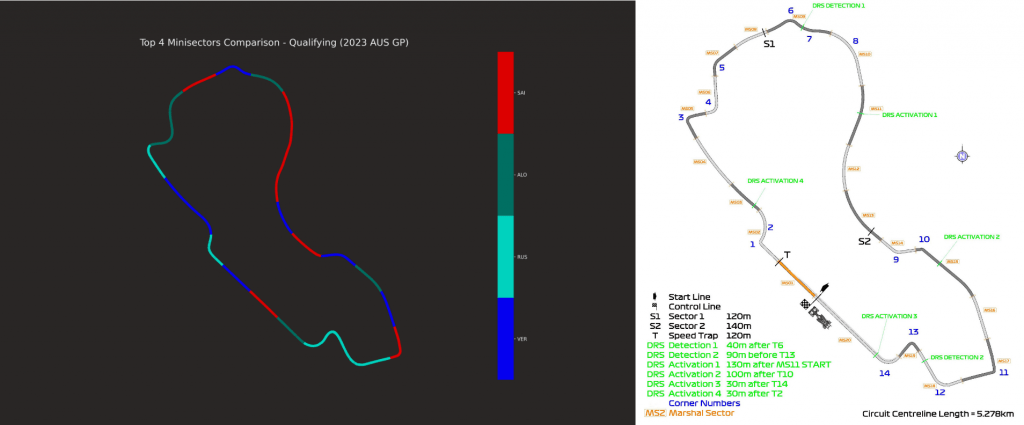
The old iteration of the Mercedes was good in cooler temperatures, faring better on the braking zones and displaying a change in direction.
2023 Miami GP
Sector 3 of the Miami circuit comprises a long straight leading to a hairpin but with a more open exit sprint to the start-finish line. Even though the hairpin in Canada is a tighter and slower one, the performance in this sector should give us a fair reflection.
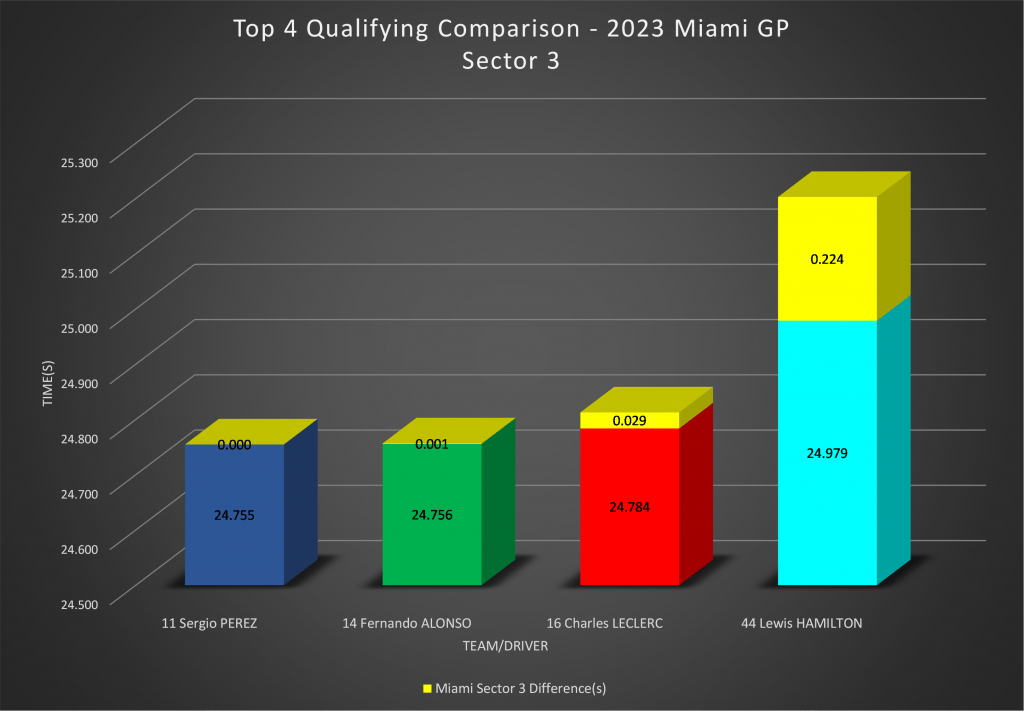
- Mercedes were the outliers, a reflection on their forgettable weekend.
- The other teams had almost identical times.
Here’s a mini-sector comparison:
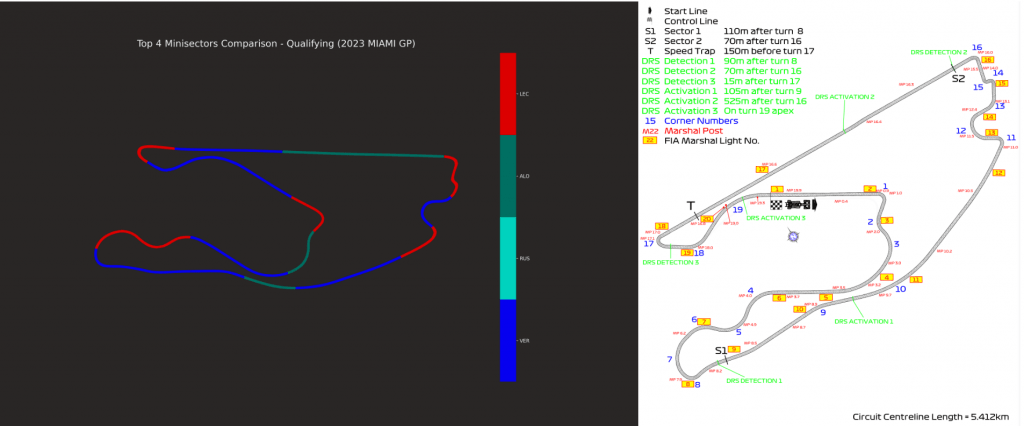
It’s a predictable trend, Red Bull being fast on the straight and then Ferrari making up its deficit in the slow hairpin.
2023 Spanish GP
In the recently concluded Spanish GP, qualifying was again dominated by Max Verstappen. But the changing conditions didn’t phase him while it caught out many drivers. There were a few surprises in the final classification – the top 4 qualifying order was a Red Bull, Ferrari, Mercedes, and Aston Martin, but the drivers struggled to be consistent and there was a lot of time left on the table.
The track in Spain is very different from the track in focus this week but there were a plethora of upgrades on display last weekend, especially by the Red team. The Mercedes W14 2.0 had its first significant test. Aston Martin and Redbull didn’t have significant upgrades on their cars.
It is paramount that the qualifying results are closely observed to see if there is a change in the order among the top 4.
Here is a bar chart comparing the potential lap times of the team and the registered fastest laps.
Potential Team Lap time: is the sum of the fastest sectors posted by either of the drivers.
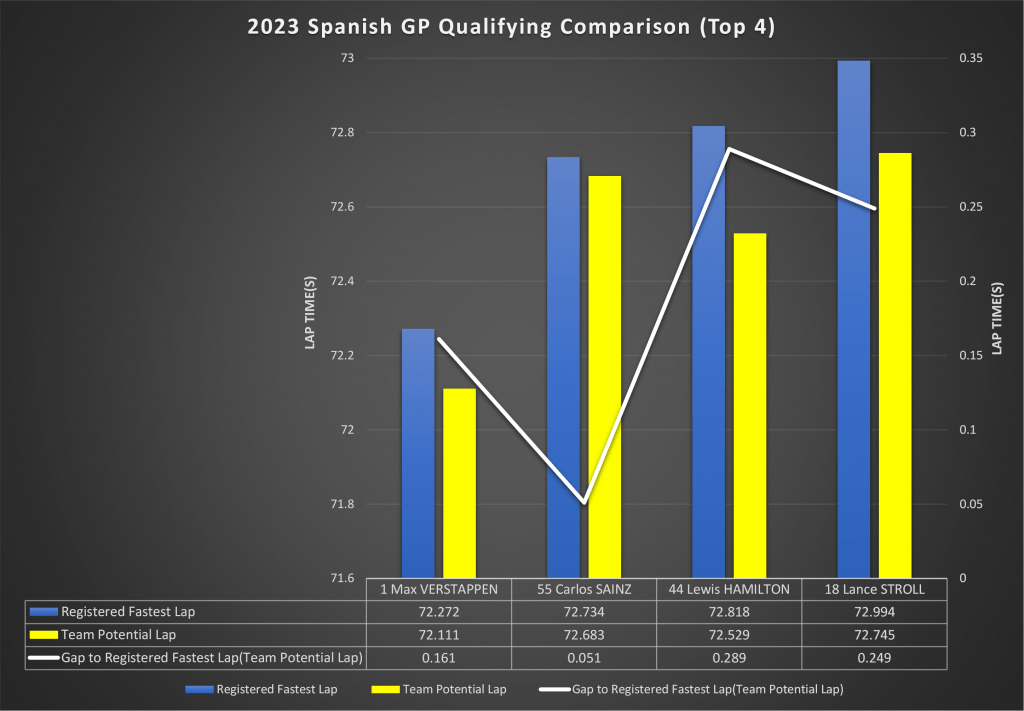
- Verstappen was in a league of his own but still didn’t string his fastest sectors together.
- In reality, Mercedes had the second fastest car but their drivers failed to stay consistent.
- Ferrari’s Sainz maximized his performance, it indeed classified him at P2 but the car was way behind the ball game.
- Aston’s time could have been better if not for Alonso’s visit to the gravel trap.
Conclusion of my F1 data prediction for Canada
Verstappen in his Red Bull is still the benchmark and all signs indicate that he will be the man to beat this weekend too.
Perez’s recent slump in form could open a window of opportunity for the trailing teams.
Mercedes’s new upgrades had a good showing in Spain and recent history tells us that cooler temperatures favour their car’s characteristics.
Ferrari deserve to bask in their glory for their historic win in Le Mans but with their pushed updates to their F1 car, they have a lot of things to worry about. Their qualifying performance was not up to the mark and their race performance was alarmingly worrisome in Spain.
Aston could bring some updates to Canada and improve on their performances from Spain.
There is a threat of rain for the upcoming weekend which could again throw the teams off their rhythm. Based on the analysis above, Mercedes could cement their place as the second-best team on the grid.
